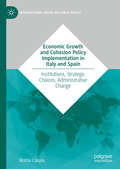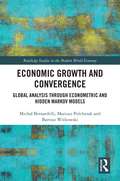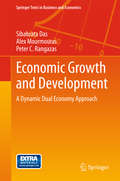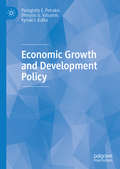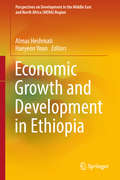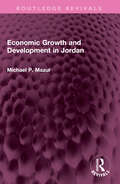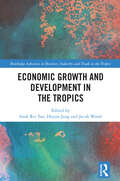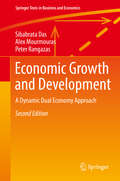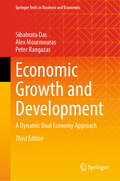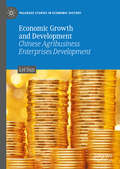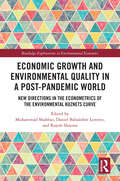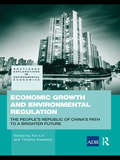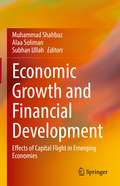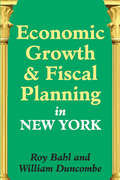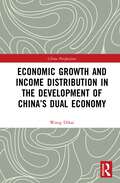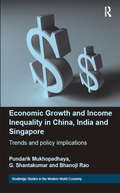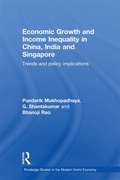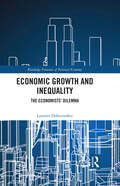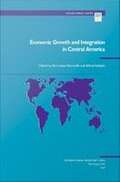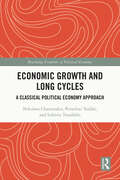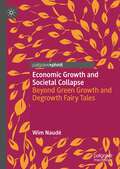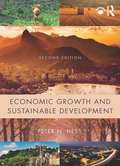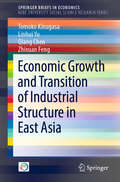- Table View
- List View
Economic Growth and Cohesion Policy Implementation in Italy and Spain: Institutions, Strategic Choices, Administrative Change (International Series on Public Policy)
by Mattia CasulaThis book concerns EU Cohesion Policy and the economic convergence of underdeveloped regions in Italy and Spain from the first programming period to the present: it investigates the political and institutional factors that determine the success or failure of implementing EU Cohesion Policy at national and sub-national level, as well as their impact on economic growth. On the wave of the American tradition of development studies, this book suggests that public policy analysis can be fruitful for understanding economic growth and cohesion, if it were to reconstruct domestic public interventions for development and the institutional characteristics of the subjects responsible for pursuing development goals. To do so, this book derives its theoretical foundations from the traditional debate on the role of state actors in promoting economic development and on the institutional characteristics that the public authorities involved in the process of economic development should display. More precisely, by adopting an Hirschmanian approach to development, it elaborates an original framework to compare different Cohesion Policy implementations and to understand its economic results in different countries, using Italy and Spain as pilot studies.
Economic Growth and Convergence: Global Analysis through Econometric and Hidden Markov Models (Routledge Studies in the Modern World Economy)
by Bartosz Witkowski Michał Bernardelli Mariusz PróchniakThere are many different types of convergence within economics, as well as several methods to analyse each of them. This book addresses the concept of real economic convergence or the gradual levelling-off of GDP (gross domestic product) per capita rates across economies. In addition to a detailed, holistic overview of the history and theory, the authors include a description of two modern methods of assessing the occurrence and rate of convergence, BMA-based and HMM-based, as well as the results of the empirical analysis. Readers will have access not only to the conventional econometric approach of β convergence but also to an alternative one, allowing for the convergence issue to be expressed in the context of automatic pattern recognition. This approach is universal as it can be adapted to a variety of input data. The lowest aggregation level study investigates regional convergence through the case of Polish voivodships, where convergence towards the leader is tested. On a higher level of aggregation, the authors examine the existence of GDP convergence in such groups as the EU28, North Africa and the Middle East, sub-Saharan Africa, South America, Caribbean, South-East Asia, Australia and Oceania, or post-socialist countries. For each group, the real β convergence is tested using the two above-mentioned approaches. The results are widely discussed, broadly illustrated, interpreted, and compared. The analysis allows readers to draw interesting conclusions about the causes of convergence or the drivers behind divergence. The book will stimulate further research in the field, but the research was conducted from the point of view of individual countries.
Economic Growth and Development
by Alex Mourmouras Sibabrata Das Peter C. RangazasGrowth theory provides a rich and versatile analytical framework through which fundamental questions about economic development can be examined. This book is an introduction to the newer features of growth theory that are particularly useful in examining the issues of economic development. Structural transformation, in which developing countries transition from traditional production in largely rural areas to modern production in largely urban areas, is an important causal force in creating early economic growth, and as such, is made central in this approach. Towards this end, the authors augment the Solow model to include endogenous theories of saving, fertility, human capital, institutional arrangements, and policy formation, creating a single two-sector model of structural transformation. Based on applied research and practical experiences in macroeconomic development, the model in this book presents a more rigorous, quantifiable, and explicitly dynamic dual economy approach to development. Common microeconomic foundations and notation are used throughout, with each chapter building on the previous material in a continuous flow. With its single model and focus on data and policy analysis, this text is intended for beginning graduate students and policy makers interested in economic development.
Economic Growth and Development Policy
by Panagiotis E. Petrakis Dionysis G. Valsamis Kyriaki I. KafkaThis book provides the theoretical and analytical background necessary to understanding the process of growth and the implementation of economic policies. First, it presents the growth theory landscape and the evolution of growth as well as modern growth theory arguments where the policy implications of the theoretical approaches are set. The book then covers the relationship between policy and growth, discussing not only the growth prototypes that prevail but also their relation to politics and economic policy formation and decision making. In this context, policy formation determinants, as well as the targets, instruments, and policy implementations, are crucial. The role of structural changes and structural reforms and their relationship with economic growth is also analyzed. The book ends with an interdisciplinary study of how institutions and cultural background, entrepreneurship and innovation affect policy formation.
Economic Growth and Development in Africa: Understanding trends and prospects (Routledge Studies in African Development)
by Horman ChitongeIn recent years, Africa has undergone the longest period of sustained economic growth in the continent’s history, drawing the attention of the international media and academics alike. This book analyses the Africa Rising narrative from multidisciplinary perspectives, offering a critical assessment of the explanations given for the poor economic growth and development performance in Africa prior to the millennium and the dramatic shift towards the new Africa. Bringing in perspectives from African intellectuals and scholars, many of whom have previously been overlooked in this debate, the book examines the construction of Africa’s economic growth and development portraits over the years. It looks at two institutions that play a vital role in African development, providing a detailed explanation of how the World Bank and the IMF have interpreted and dealt with the African challenges and experiences. The insightful analysis reveals that if Africa is rising, only 20-30 per cent of Africans are aboard the rising ship, and the main challenge facing the continent today is to bring on board the majority of Africans who have been excluded from growth. This book makes the complex, and sometimes confusing debates on Africa’s economic growth experience more accessible to a wide range of readers interested in the Africa story. It is essential reading for students and researchers in African Studies, and will be of great interest to scholars in Development Studies, Political Economy, and Development Economics.
Economic Growth and Development in Ethiopia (Perspectives On Development In The Middle East And North Africa (mena) Region Ser.)
by Almas Heshmati Haeyeon YoonThis volume is a collection of selected empirical studies on determinants of economic growth and development in Ethiopia.The core argument for editing this book is to provide an up-to-date picture of the state and patterns of growth and development in Ethiopia. Ethiopia has been under focus in the past due to draughts, war, famine, development changes and the effects of global economic crisis in the country. A main contribution of this volume is that it helps identify selected important determinants of growth and development in Ethiopia and provides an estimation of their effects using up-to-date data, modelling and methods. Taken together the studies provide a comprehensive picture of the state of growth and development, their measurements, causal relationships and evaluation of efficient policies and practices in achieving progress in Ethiopia. The issues covered represent major challenges to the government and development organizations who are aiming at achieving higher growth and alleviating poverty in the country. The studies cover transition from rural agriculture to urban industry and the development of services.
Economic Growth and Development in Jordan (Routledge Revivals)
by Michael P. MazurFirst Published in 1979 Economic Growth and Development in Jordan is a comprehensive analysis of the economies of pre-1967 Jordan and the post-1967 East Bank. Part I includes statistical data that measures the growth performance of Jordan’s prewar economy and presents the first quantitative explanation of its concentration in the service sector. Part II surveys the postwar East Bank economy, including a critical analysis of statistical data. The third section of the book covers Jordan’s development policies and experiences in the areas of agriculture, industry, and planning. Dr Mazur concludes with speculations on the future of the Jordanian economy with and without a Middle East peace settlement. This is an interesting read for students and researchers of economics, Middle East studies and Middle East economics.
Economic Growth and Development in the Tropics (Routledge Advances in Business, Industry and Trade in the Tropics)
by Jacob Wood Sook Rei Tan Haejin JangThe living standards and scale of development around the world are vastly unequal. One notable observation is that much of the poverty-stricken area is located between the tropics of Cancer and Capricorn. By contrast, affluent nations are situated in more temperate zones. Such a phenomenon gives weight to the geography hypothesis that seeks to explain the occurrence of global economic inequality, by placing an emphasis on the importance of natural elements such as location and climate in determining the economic conditions of a nation. This book concentrates exclusively and in depth on the key economic phenomena and factors which shape tropical economies today. It examines contemporary economic problems confronting the tropical countries and provides policy recommendations that align with the United Nations’ Sustainable Development Goals set in the 2030 Agenda. It contains research works and case studies of tropical economies that are related to the area of development and environment economics. The book’s themes range from economic growth, poverty reduction, income inequality, economic globalization, international trade, capital flow, financial development, and institutional development to environmental sustainability within the Tropics. Recognizing the dynamism and diversity of the tropics, the book encompasses empirical and policy analyses that address the key economic issues and challenges in the region so as to provide an important platform from which new policymaking initiatives can flourish. This book will draw readership primarily from the fields of economics and public policy, particularly under the subject areas of development and environment economics, as well as discussions in the sustainability policy space.
Economic Growth and Development: A Dynamic Dual Economy Approach (Springer Texts in Business and Economics #42)
by Alex Mourmouras Peter Rangazas Sibabrata DasThis text is an introduction to the newer features of growth theory that are particularly useful in examining the issues of economic development. Growth theory provides a rich and versatile analytical framework through which fundamental questions about economic development can be examined. Structural transformation, in which developing countries transition from traditional production in largely rural areas to modern production in largely urban areas, is an important causal force in creating early economic growth, and as such, is made central in this approach. Towards this end, the authors augment the Solow model to include endogenous theories of saving, fertility, human capital, institutional arrangements, and policy formation, creating a single two-sector model of structural transformation. Based on applied research and practical experiences in macroeconomic development, the model in this book presents a more rigorous, quantifiable, and explicitly dynamic dual economy approach to development. Common microeconomic foundations and notation are used throughout, with each chapter building on the previous material in a continuous flow. Revised and updated to include more exercises for guided self study, as well as a technical appendix covering required mathematical topics beyond calculus, the second edition is appropriate for both upper undergraduate and graduate students studying development economics and macroeconomics.
Economic Growth and Development: A Dynamic Dual Economy Approach (Springer Texts in Business and Economics)
by Alex Mourmouras Peter Rangazas Sibabrata DasRevised and updated for the third edition, this text is an introduction to the newer features of growth theory that are particularly useful in examining the issues of economic development. Growth theory provides a rich and versatile analytical framework through which fundamental questions about economic development can be examined. Structural transformation, in which developing countries transition from traditional production in largely rural areas to modern production in largely urban areas, is an important causal force in creating early economic growth, and as such, is made central in this approach. Towards this end, the authors augment the Solow model to include endogenous theories of saving, fertility, human capital, institutional arrangements, and policy formation, creating a single two-sector model of structural transformation. Based on applied research and practical experiences in macroeconomic development, the model in this book presents a more rigorous, quantifiable, andexplicitly dynamic dual economy approach to development. Common microeconomic foundations and notation are used throughout, with each chapter building on the previous material in a continuous flow. The updated third edition includes two completely new chapters on government debt and growth slowdowns, topics that will be useful for undergraduate and graduate students studying development economics and macroeconomics.
Economic Growth and Development: Chinese Agribusiness Enterprises Development (Palgrave Studies in Economic History)
by Lei SunThis book analyses the important role of agribusiness and rural enterprises in economic growth and development. China’s inclusive development of agribusiness and rural enterprises has played a pivotal role in economic growth, sustainable development and poverty reduction. This book analyses how market, price and institution are important factors for China’s inclusive development of agribusiness and rural enterprises. Incentive property rights of farming lands have impacted the allocation efficiency of resources in markets, which contributed to the growth of its agro-industrial development and the families-agribusiness. The technological changes contributed to the agricultural growth in China pre and post economic reform phases. The book introduces the combination development approach (CDA) of agribusiness and rural enterprises. The combination development approach of agribusiness and rural enterprises facilitates developing countries to upgrade into emerging economies and industrial economies. The book presents theoretical perspectives of development economics, and it introduces cutting-edge international development issues, and China’s international economic cooperation on international trade and enterprises development. New technology and information technology bring new business opportunities to smallholder farmers in transitional economies and developing countries to access global value chain in the future.
Economic Growth and Environmental Quality in a Post-Pandemic World: New Directions in the Econometrics of the Environmental Kuznets Curve (Routledge Explorations in Environmental Economics)
by Muhammad Shahbaz, Daniel Balsalobre Lorente, and Rajesh SharmaIn response to the damage caused by a growth-led global economy, researchers across the world started investigating the association between environmental pollution and its possible determinants using different models and techniques. Most famously, the environmental Kuznets curve hypothesizes an inverted U-shaped association between environmental quality and gross domestic product (GDP). This book explores the latest literature on the environmental Kuznets curve, including developments in the methodology, the impacts of the pandemic, and other recent findings. Researchers have recently broadened the range of the list of drivers of environmental pollution under consideration, which now includes variables such as foreign direct investment, trade expansion, financial development, human activities, population growth, and renewable and nonrenewable energy resources, all of which vary across different countries and times. And in addition to CO2 emissions, other proxies for environmental quality – such as water, land, and ecological footprints – have been used in recent studies. This book also incorporates analysis of the relationship between economic growth and the environment during the COVID-19 crisis, presenting new empirical work on the impact of the pandemic on energy use, the financial sector, trade, and tourism. Collectively, these developments have improved the direction and extent of the environmental Kuznets curve hypothesis and broadened the basket of dependent and independent variables which may be incorporated. This book will be invaluable reading for researchers in environmental economics and econometrics.
Economic Growth and Environmental Regulation: China's Path to a Brighter Future (Routledge Explorations In Environmental Economics Ser. #20)
by Tim Swanson Tun LinThis volume assembles a group of eminent scholars to look at the problem of growth and environment from the perspective of environmental regulation. The questions addressed are: How does economic growth interact with regulation, and what are the best approaches to regulation in use today? The context for the volume is the current situation in China, where twenty years of rapid growth have created a situation in which there are both demands for environmental regulation and needs for choosing a future development path. The advent of "A Macro-Environmental Strategy" for China presents an opportunity to ask how and why China should introduce regulation into its management of its development. The volume includes contributions from leading Chinese experts and established environmental economists from other countries including Timo Goeschl, Ben Groom and Andreas Kontoleon. The volume looks at both the demand side of environmental regulation and the supply side. The demand side of regulatory intervention examines how regulation operates to supplement existing resource-allocation mechanisms, via effective demand aggregation and implementation mechanisms. The supply side of regulation examines how regulation operates to guide industrial growth down particular pathways, in the pursuit of managed development. Both sides of environmental regulation involve the important issue of implementation and enforcement. This volume will be of most value to academics and scholars of environmental economics, growth economics, the Chinese economy and policy-makers of environmental regulations.
Economic Growth and Environmental Sustainability: The Prospects for Green Growth
by Paul EkinsA key area of public policy in the last twenty years is the question of how, and how much, to protect vthe environment. At the heart of this has been the heated debate over the nature of the relationship between economic growth and environmental sustainability. Is environemental sustainability economic growth or `green growth', a contradiction in terms? Avoiding the confusion that often surrounds these issues, Ekins provides rigorous expositions of the concept of sustainability, integrated environmental and economic accounting, the Environmental Kuznets Curve, the economics of climate change and environmental taxation. Individual chapters are organised as self-contained, state-of-the-art expositions of the core issues of environmental economics, with extensive cross-referencing from one chapter to another, in order to guide the student or policy-maker through these complex problems. Paul Ekins breaks new ground in defining the conditions of compatibility between economic growth and environmental sustainability, and provides measures and criteria by which the environmental sustainability of economic growth, as it occurs in the real world, may be judged. It is argued that `green growth' is not only theoretically possible but economically achievable and the authors show what environmental and economic policies are required to achieve this. Economic Growth and Environmental Sustainability will be welcolmed by students of and researchers in environmental economics and environmental studies, as well as all interested policy-makers.
Economic Growth and Financial Development: Effects of Capital Flight in Emerging Economies
by Muhammad Shahbaz Alaa Soliman Subhan UllahThis book looks into the relationship between financial development, economic growth, and the possibility of a potential capital flight in the transmission process. It also examines the important role that financial institutions, financial markets, and country-level institutional factors play in economic growth and their impact on capital flight in emerging economies. By presenting new theoretical insights and empirical country studies as well as econometric approaches, the authors focus on the relationship between financial development and economic growth with capital flight in the era of financial crisis. Therefore, this book is a must-read for researchers, scholars, and policy-makers, interested in a better understanding of economic growth and financial development of emerging economies alike.
Economic Growth and Fiscal Planning in New York
by William DuncombeIn an era of federal deficits and struggling municipalities, states have emerged as the most significant governmental actors. But state governments face the major challenge of fiscal planning in the midst of economic change. Roy Bahl and William Duncombe tackle this challenge head-on. Using New York as a case study, they identify looming dangers for state revenue and expenditure planning.Bahl and Duncombe begin with the premise that one cannot separate an evaluation of fiscal performance from an evaluation of economic performance. Accordingly, they describe and analyze the patterns of population, employment, and personal income growth. Following this is a study of state and local government finances in New York since 1970 and a recounting of the fiscal adjustments that were taken in the face of slower and then faster growth in the economy.The authors conclude that based on current conditions, the state and its local governments are in for fiscal belt-tightening. They note that the state should take a comprehensive view in planning the development and retrenchment of its government sector. The book is thought-provoking, exhaustively researched, and sensibly written. Its lessons are applicable everywhere and should be read by all those seeking a route through the tangled thicket of government policy for economic growth.
Economic Growth and Income Distribution in the Development of China’s Dual Economy (China Perspectives)
by Wang DihaiSince the start of the process of economic reform in 1978, China has maintained the structure of a dual economy, with concurrent development of the agricultural and industrial sectors. This book explores the key issues of China's economic growth and income distribution in this context.Pivoting on analysis of China's real GDP and growth rate, the first part of the book analyzes the evolution of economic growth and characteristics of economic structural changes across a period of forty years, scrutinizing the different determinants that contribute to growth. Then, chapters in the second part of the volume study the relationship between China's economic growth and economic development, elucidating the mechanism of interaction between the former and key factors of the latter, including investment, housing, education, and healthcare. The final chapters center on the development and current landscape of income distribution, providing explanation for sharpening income inequalities and advancing suggestions and feasible solutions to the problem of income gap.This book is targeted at scholars, students, and policymakers interested in China's economy, income distribution, and economic growth.
Economic Growth and Income Inequality in China, India and Singapore: Trends and Policy Implications (Routledge Studies In The Modern World Economy Ser.)
by Pundarik MukhopadhayaThe world at large is watching both China and India as powerhouses of economic growth. The two nations have achieved significantly high rates of economic growth ever since their respective economies liberalized in 1978 and 1991. Singapore, despite its limited land size and almost total dependence on external trade, has performed remarkably well and has moved �from the third world to the first�. This book documents and explains the rapid economic growth of the three key Asian economies.The book also looks at what has happened to income inequality in the context of superior growth performance. It makes comparative assessments and examines the implications for the three nations. Since free markets have nothing in them to produce a reduction in income inequality among persons/households, one must at best hope for equality of opportunity � notably reflected in identical schooling for all; identical health care for all; and minimal rather than vulgar inequality in housing. This book is particularly useful for both China and India which may wish to study and learn from Singapore in regard to the policies, programmes and projects aimed at ensuring equality of opportunity. The book is backed by considerable expertise on the part of the researchers, with demonstrated expertise through their publications spawning a few decades. It is invaluable to those who are concerned with designing policies for developing countries aimed at rapid and inclusive economic growth.This book has been made possible by the intellectual and financial support extended by the Global Asia Institute, National University of Singapore.
Economic Growth and Income Inequality in China, India and Singapore: Trends and Policy Implications (Routledge Studies in the Modern World Economy)
by Pundarik Mukhopadhaya Bhanoji Rao G ShantakumarThe world at large is watching both China and India as powerhouses of economic growth. The two nations have achieved significantly high rates of economic growth ever since their respective economies liberalized in 1978 and 1991. Singapore, despite its limited land size and almost total dependence on external trade, has performed remarkably well and has moved ‘from the third world to the first’. This book documents and explains the rapid economic growth of the three key Asian economies. The book also looks at what has happened to income inequality in the context of superior growth performance. It makes comparative assessments and examines the implications for the three nations. Since free markets have nothing in them to produce a reduction in income inequality among persons/households, one must at best hope for equality of opportunity – notably reflected in identical schooling for all; identical health care for all; and minimal rather than vulgar inequality in housing. This book is particularly useful for both China and India which may wish to study and learn from Singapore in regard to the policies, programmes and projects aimed at ensuring equality of opportunity. The book is backed by considerable expertise on the part of the researchers, with demonstrated expertise through their publications spawning a few decades. It is invaluable to those who are concerned with designing policies for developing countries aimed at rapid and inclusive economic growth. This book has been made possible by the intellectual and financial support extended by the Global Asia Institute, National University of Singapore.
Economic Growth and Inequality: The Economists' Dilemma (Routledge Frontiers of Political Economy)
by Laurent DobuzinskisIn an era of increasing inequalities, and also of deep anxieties about the consequences of two major economic crises, economists are faced with a major question: can economic growth be achieved without inequalities? Economic Growth and Inequality critically evaluates the economic literature on this question from a pragmatic perspective, seeking to reconcile those who regard economic liberties as a paramount value, and critics who object that prioritizing these liberties leads to inequitable outcomes. The book presents an overview of the models used by economists to define and measure inequalities and the ongoing dialogues between political philosophers and economists in an effort to find solutions to the problems. It explores Rawlsian justice, Sen’s capability theory, and the theory of rent and compares and contrasts the most often discussed institutions and policies designed for remedying poverty and reducing inequalities. This book marks a significant contribution to the literature on some of the most pressing problems of our time and will be of great interest to readers of political economy, public policy, moral philosophy, and history of economic and political thought.
Economic Growth and Integration in Central America
by Alfred Schipke Dominique DesruelleThere is optimism about the economic performance and prospects of South America. The essays in this regional assessment are entitled: overview; growth performance; pension reform; assessing sovereign debt structures; Financial Sector Development: Public Debt Markets; and Characterizing Monetary Policy
Economic Growth and Long Cycles: A Classical Political Economy Approach (Routledge Frontiers of Political Economy)
by Lefteris Tsoulfidis Persefoni Tsaliki Nikolaos ChatzarakisContemporary capitalism is characterized by periods of vigorous economic growth and periods of slow or even negative growth. This book draws on the classical political economy approach to consider both economic cycles and economic growth and draw conclusions about the inherent instability of the modern economy. The book shows that the work of the old classical economists (Smith and Ricardo) and Marx is theoretically sound and capable of providing answers to both growth and cycles. It also demonstrates the potential and natural integration of growth and cycles in a single model. The microeconomic foundation of this model is the labor theory of value, which continues with the General Law of Capital Accumulation, the Law of the Falling Rate of Profit, and the movement of the Industrial Reserve Army of Labour. Finally, a dynamic model of growth-cum-cycles is constructed consisting of the evolution and interaction of five key variables, namely, the rate of profit, the propensity to invest in fixed capital, technological change, the reserve army of labour, and the rate of capital devaluation. The analysis demonstrates that economic growth and cycles are not disconnected from each other, as they have been treated in the literature, but rather interdependent aspects of the same evolutionary process of a capitalist economy. This book will interest readers in the history of economic thought, economic growth and development, macroeconomics, and political economy.
Economic Growth and Societal Collapse: Beyond Green Growth and Degrowth Fairy Tales
by Wim NaudéIt has been said that, in the light of ecological overshoot, that human civilization faces two future possibilities: a Great Decoupling or a Great Collapse. In this book, two distinct positions to achieve the Great Decoupling are critically evaluated: Green Growth and Degrowth. It is concluded that neither Green Growth nor Degrowth will be able to achieve the Great Decoupling. The possibility for society to collapse is then raised, with the potential for a civilizational rebound pondered. Whether collapse may be a feature, and not a bug, of the long-run evolution of complex civilization is discussed.This book offers a thought provoking and unique perspective on the economic and ecological challenges faced by modern societies. It will be relevant to students, researchers, and policymakers interested in environmental economics and economic policy.
Economic Growth and Sustainable Development
by Peter N. HessEconomic growth, reflected in increases in national output per capita, makes possible an improved material standard of living and the alleviation of poverty. Sustainable development, popularly and concisely defined as ‘meeting the needs of the present generations without compromising the ability of future generations to meet their needs,' directly addresses the utilization of natural resources, the state of the environment, and intergenerational equity. Now in its second edition, Economic Growth and Sustainable Development features expanded discussion of income distribution, social capital and the insights of behavioural economics for climate change mitigation. Boxed case studies have been added which explore the impact of economic growth on people and countries in both the developed and developing world. This text addresses the following fundamental questions: ? What causes economic growth? Why do some countries grow faster than others? What accounts for the extraordinary growth in the world’s population over the past two centuries? What are the current trends in population and will these trends continue? How do we measure sustainable development and is sustainable development compatible with economic growth? Why is climate change the greatest market failure of all time? What can be done to mitigate climate change and global warming? ? With a blend of formal models, empirical evidence, history and policy, this text provides a coherent and comprehensive treatment of economic growth and sustainable development. It is suitable for those who study development economics, sustainable development and ecological economics.
Economic Growth and Transition of Industrial Structure in East Asia (SpringerBriefs in Economics)
by Tomoko Kinugasa Linhui Yu Qiang Chen Zhixuan FengThis book explores new frontiers in the research of economic growth and industrial reconstruction, analyzing economic growth and transitions in industrial structure in East Asia with a variety of data. First, the effects of demographic change on trade openness is analyzed empirically using the panel data of APEC countries. Second, the determinant of wage and housing costs are estimated using survey data collected from peasant workers in China. Third, the determinants of conquests among nomads in or near China and dynasties from world history are analyzed empirically using data regarding dynasties. Fourth, critiques on Emmanuel’s unequal exchange theory are investigated based on the profit data in the world. This book is highly recommended for readers who would like to obtain a new idea about economic development in terms of industrial structure.
